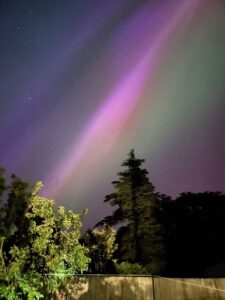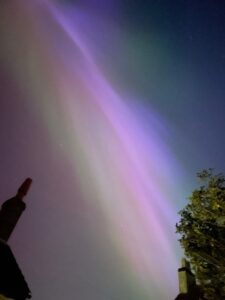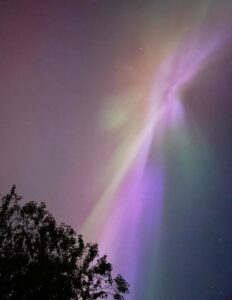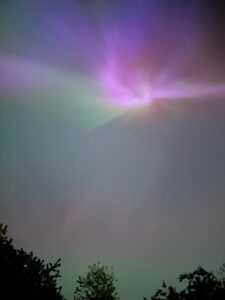Good morning, Prep School family,
I hope you are well and enjoyed the beautiful weather this last week. I had a wonderful weekend and managed to tick something off my bucket list – seeing the Northern Lights with the added bonus that it was from my own back garden. It was truly spectacular and something that I have wanted to see for many years. Mr Bennett and I sat outside with an adult beverage and watched the show unfold above us. The colours and the movement of the lights were amazing and I felt so lucky to have witnessed something so special. It did get me thinking though about what actually are the Northern Lights, or Aurora Borealis to use its proper name, so I did some research and found these fun facts:
Fun Fact 1 – The Northern Lights are also known by the name ‘Aurora Borealis’. Aurora was the Roman Goddess of the Dawn and Boreas is Greek for north wind.
Fun Fact 2 – The Northern Lights are not visible all the time but when they do appear, they are often sighted within the Arctic Circle, approximately more than 80 kilometres from the surface of the Earth.
Fun Fact 3 – There are certain times of the year when you are more likely to witness the Northern Lights. This is when the greatest solar winds occur, usually between early September and early March.
Fun Fact 4 – The display of Northern Lights is said to be a truly fantastic experience and very awe inspiring. During the Aurora season many people visit areas including Alaska, Iceland and Norway for a holiday vacation, in the hope of catching this amazing natural wonder of the world.
Fun Fact 5 – The Northern Lights dance in ribbons and circular patterns through the sky, shedding spears of lights in wonderful colours which can be green, blue, purple or red.
Fun Fact 6 – People travel for miles and pay a lot of money in hope of seeing the Northern Lights which are a huge tourist attraction. Some visitors have to wait weeks before being lucky enough to experience this phenomenon. Some do not witness them at all.
Fun Fact 7 – Although the beams are usually seen within the Arctic Circle, they have been spotted in other parts of the world including the United Kingdom.
Fun Fact 8 – What causes the Northern Lights? The coloured beams are created by electronically charged particles from the sun which enter the Earth’s atmosphere when solar winds are powerful.
Fun Fact 9 – The Earth has its own magnetic field which protects us against solar winds most of the time. However, sometimes electronic particles can pass through the atmosphere surrounding our Earth where the magnetic field is weaker.
Fun Fact 10 – There are many myths surrounding the dancing lights of the Aurora Borealis. Some believe the mystical phenomenon to be a ‘Dance of the Spirits’. There are lots of legends and myths which have been around throughout history.
Fun Fact 11 – The colour of the lights depend upon the atmosphere. Green light is given off high in the atmosphere where as the lower lights at lower altitudes can be other colours such as blue or purple.
Fun Fact 12 – The Northern Lights Oval is the area which provides the greatest possibility of seeing the Aurora Borealis. This area includes Alaska, parts of Canada, Norway, Greenland, Sweden, Finland and Iceland.
Fun Fact 13 – It has to be dark to see the Northern Lights at their greatest, between the hours of 6pm and 4am are usually the best.
Fun Fact 14 – The Northern Lights are not predictable so nobody knows when the next display of lights is going to be. The weather has a huge impact on the visibility. The chance of seeing the Aurora Borealis are higher during the coldest, darkest months of the year on clear days.
Fun Fact 15 – Many of the best viewing areas are remote and due to extreme weather conditions they are inaccessible.
Fun Fact 16 – Did you know that the Northern Lights are one of the Seven Wonders of the Natural World.
It was also a remarkable reminder to stop, breathe, take in the world around us and never stop looking for wonder and awe in each and every moment. Nature is inspiring. I have attached some of my photos to the Bulletin – these are completely unedited and unfiltered – aren’t they beautiful.
Quote of the week: “Nothing will come of nothing; we must dare mighty things.” – William Shakespeare
Well-being tasks for this week: These tasks are based on Meaningful May. Actions to help us find ways to be part of something bigger.
Tuesday 14 May – Go outside and notice the beauty in nature
Wednesday 15 May – Do something to contribute to your local community
Thursday 16 May – Show your gratitude to people who are helping to make things better
Friday 17 May – Find a way to make what you do today meaningful
Saturday 18 May – Send a hand-written note to someone you care about
Sunday 19 May – reflect on what makes you feel valued and purposeful
Monday 20 May – Share photos of three things you find meaningful or memorable
Jokes of the week:
What is a witch’s favourite subject in school? Spelling!
Why didn’t the zombie go to school? He felt rotten.
What did one plate say to the other plate? “Dinner’s on me.”
Why did the pony get sent to his room? He wouldn’t stop horsing around.
What do you call a cow that eats your grass? A lawn moo-er.
Conversation starters:
What was the worst thing you have ever eaten? Why was it so bad?
If you could put anything on top of a pizza, what would it be?
5 things that I am grateful for or looking forward to this week:
Can you try this simple exercise in gratitude and positivity?
- I am looking forward to seeing my extended family at the weekend
- I am looking forward to Reception Sports Day (fingers crossed it does not rain)
- I am looking forward to starting my new book
- I am grateful for the sunshine
- I am grateful for people’s kindness
Sleeps til Santa: 224 sleeps. . .
Wishing you a lovely week.
With love,
Mrs Bennett
